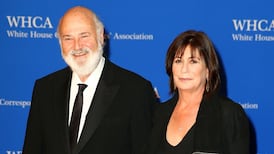Breastfeeding groups are concerned at an EU work-life balance poster, writes FIONA McCANN
A EUROPEAN Parliament postcard campaign aimed at encouraging the electorate to vote in the upcoming European Parliament elections has been criticised by breastfeeding campaigners for the use of an image of a baby’s bottle.
The campaign postcard, captioned “How should we help balance family and career?”, depicts an open laptop beside a bottle. The HSE’s National Breastfeeding Co-ordinator, Maureen Fallon, says that using symbols like a feeding bottle normalises formula feeding.
“It’s a very powerful image,” she says. “It is normalising something that isn’t recommended and that is not health-promoting like breastfeeding is.
“We shouldn’t be normalising something that isn’t recommended as best practice.”
Fallon says the impact of such an image and the power of marketing and images in shifting cultural perceptions, even about choices as personal as how to feed your baby, should not be underestimated.
Gabrielle Palmer, author of The Politics of Breastfeeding, is a long- time advocate of breastfeeding. She too has criticised the EU postcard. "I think it's such an insult to symbolise family life with a bottle."
She says millions of euros is spent on promoting baby food and bottle formula in defiance of a World Health Organisation (WHO) code.
“It’s very successful because they’ve changed the culture,” she explains, pointing to the shift from breastfeeding that occurred across the developed world once formula feeds were introduced.
“To me, it’s a pincer movement between health service incompetence and ignorance, and marketing. They work terribly well together.”
The European Parliament has defended the postcard. “The idea was to focus on women and men, that bottles would be used by both women and men when feeding a child,” according to Eimear Ní Bhroin, the European Parliament’s Dublin press officer.
“In a previous campaign, breastfeeding was used, but this one was an attempt to look at family in a male and female context. It wasn’t meant to be a formula bottle necessarily. It doesn’t exclude breastfeeding.”
She says MEPs have been involved in resolutions on breastfeeding, in looking at the importance of breastfeeding as nourishment and the ways mothers can be facilitated.
Several MEPs have been active and vocal in promoting breastfeeding and maternity rights, with Danish MEP Hanne Dahl even bringing her daughter Gaia to parliament last month.
According to Ní Bhroin, the campaign is about trying to get people thinking about what MEPs are involved in and what the European Parliament does.
Palmer says the European Parliament defence does not wash.
“There are small amounts, very small amounts, of women who express their milk and it will be bottle-fed by their husbands, but that is a tiny minority. The fact is that in Europe, the majority of bottle feeding is done by women.”
Palmer argues that the campaign directly controverts the blueprint for action publication.
“We pay our MEPs their wonderful salaries, and then they produce this stuff which was vetted and signed off by every country in Europe, and then it’s launched and ignored!”
According to a European Commission publication, Protection, Promotion and Support of Breastfeeding in Europe: a Blueprint for Action, launched in Dublin five years ago, "the promotion of breastfeeding is one of the most effective ways to improve the health of our children".
The Department of Health’s own five-year plan sets out similar standards, stating that “breastfeeding offers mothers and babies significant health advantages both in the short term and throughout their lives.”
Despite this, studies show that fewer than 50 per cent of new mothers in Ireland initiate breastfeeding, while the percentage that continues to do so after infants reach four months declines dramatically.
The World Health Organisation recommends exclusive breastfeeding for the first six months of life, followed by continued breastfeeding with appropriate complementary foods for up to two years or beyond.







